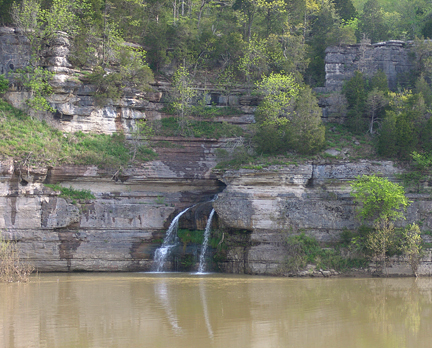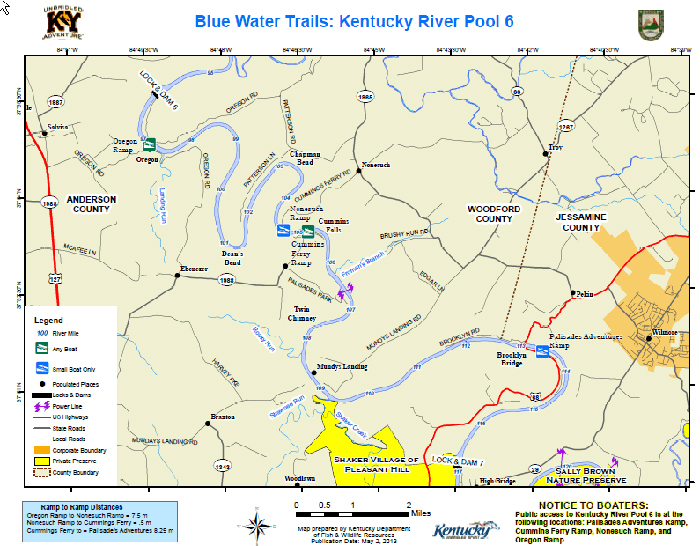
BY Lee McClellan
Frankfort, KY. – James Harrod and a company of men launched their canoes in May of 1774 from old Redstone Fort on the Monongahela River in Pennsylvania, bound for the spring-rich meadow land of central Kentucky.
He scouted the area the previous year while on a surveying expedition with Capt. Thomas Bullitt and returned determined to establish settlement. Harrod’s party floated down the Ohio and worked up the Kentucky River. They beached their canoes near the mouth of a small creek, now called Landing Run, and traveled overland along a buffalo road to a large spring surrounded by natural meadows, not far from the Salt River.

Harrod and company made crude improvements, laid out lots and built rudimentary shelters. In June of 1774, the party named the spot Harrodstown after their leader. The fledgling community was later renamed Harrodsburg, the first settlement in the state of Kentucky.
Paddlers on Pool 6 of the Kentucky River can understand why the earliest pioneers migrated to this area. The stunning cliffs of the lower Palisades combined with the rolling green hills of the Inner Bluegrass Region greet the eyes of kayakers and canoeists on Pool 6, where they can also catch quality black bass, crappie, bluegill and large muskellunge.
Two floats grant the paddler a journey through the most historic areas of Kentucky on Pool 6. You’ll float past long-forgotten river landings and ferry crossings that gave rise to flourishing, prosperous communities that are now backwaters, much of the infrastructure derelict or gone.
The first float begins at Brooklyn, Kentucky at a ramp known as Palisade Adventures and ends at Cummins Ferry Campground and Marina, eight miles downstream. The drive down U.S. 68, whether from Harrodsburg or Lexington, is one of the most spectacular in Kentucky for history and scenery. The ramp is on a nondescript road across the highway from the ruins of George Chinn’s Cave House gas station and store.
You know you are at the right place when you see a large steel boat hull on blocks. It doesn’t seem welcoming, but you’ll see an honor box emblazoned with the $3 ramp fee in letters at the top of the ramp.
After putting in at Brooklyn, you’ll see the U.S. 68 Bridge come into view as you paddle through some of the most majestic bluffs in the entire Palisades. Just upstream of the bridge on the right (looking downstream), you’ll see the abandoned Boone Tunnel, the first tunnel built for highway use in Kentucky. Crews constructed this tunnel along with the first Brooklyn Bridge in 1871, replacing the historic Cogar Ferry.
Just downstream of the bridge on the right, the rocky shoal known as Singleton Landing juts out in the river. This would make an excellent spot to work a medium running crawfish-colored crankbait for black bass, especially smallmouths. The eddy on the downside of the shoal makes a good spot to toss a brown and orange jig and trailer combination for spotted and largemouth bass.
The river straightens out for nearly three miles before taking a bend to the right. In the corner of the bend, Shawnee Run enters the river. You will see a gap in the line of trees and a small bluff that glows golden in the morning sun on the left that signals the mouth of this historic creek.
Mundy’s Landing lies on the Woodford County side of the river opposite the mouth of Shawnee Run. This landing proved vitally important for the shipment of the fluorspar and calcite mined along the river in this area by the Chinn Mineral Company. Some older maps, guidebooks and navigation charts show a boat ramp at Mundy’s Landing, but it is private property.
The lower section of Shawnee Run is an excellent spot to fish a large white spinnerbait with golden blades alongside logs for muskellunge. Fisheries biologists report seeing muskellunge in Pool 6 longer than the 36-inch minimum size length to qualify for Kentucky’s Trophy Fish/Master Angler program. The bar opposite the mouth of Shawnee Run is a good spot to fish a medium-crankbait in the firetiger color for black bass.
Just around the bend on the right is the imposing Chinn Homestead, its grandeur demonstrating the wealth generated by their mineral concerns. Rocky Run enters on the left a about one-half mile downstream. The mouth of this creek is a good spot to fish a weightless, white soft plastic jerkbait along sunken logs for black bass.
The river takes a right and a large palisade comes into view on your left. Toward the end of this bluff lies the Twin Chimney Rock formation, home to a large fluorspar mine in the early 20th Century. The rock bank at the base of this bluff makes a productive area to fish Rapala style minnow baits for spotted bass.
The river bends left into one of the tallest bluffs in this section of the Palisades. Froman’s Branch enters the river on the right and the rocky bar at its mouth is a good spot to fish crawfish-colored crankbaits, green pumpkin skirted double-tailed grubs or brown and orange jig and trailer combinations for black bass.
The river bends left again and horizontal streaks of ochre, grey blue, charcoal, rust and cream meet the eye. This is the bluff containing Cummins Falls, a double waterfall that empties straight into the river for much of the year. The take-out at Cummins Ferry Campground and Marina Ramp is on the left, directly across river from Cummins Falls.
The next float of seven miles begins at Cummins Ferry Ramp and ends at Oregon Ramp. At the end of the bluff that holds Cummins Falls, the river takes a hard right bend and Nonesuch Ramp appears. This ramp can be used as a put-in or take-out, but the shuttle for the other accesses on the south side of the river is lengthy.
After rounding Cummins Bend, the river straightens for a short time before flowing left around Chapman Bend. The rocky banks on the right side of the river along Chapman Bend are good spots to fish for black bass. The river flows straight for a mile before making the hairpin turn of Dean’s Bend.
Any sunken tree or branches in this stretch should be probed with 1/16-chartreuse Roadrunners for crappie. Large bluegill also strike this offering.
This area of the Kentucky River was one of the busiest during the steamboat era from after the Civil War until the 1920s. Misjudging one of these bends would’ve earned the operator the epithet of “cornfield sailor,” derogatory slang for an incompetent steamboat pilot.
After rounding Dean’s Bend, the river gently turns back left and around the final bend before flowing past Capt. Preston’s Landing. Capt. Squire Jordan Preston was one of the most revered and widely known steamboat pilots on the Kentucky River. His family also built steamboats at his landing near Oregon. The Falls City II and the Grace Morris were two of the most well-known boats he piloted. Other river pilots steamed by Capt. Prestons’ Landing and blew their whistles in honor at his funeral in 1919.
The river again bends back toward the right and Landing Run enters the river on the left, the spot where James Harrod’s company beached their canoes in 1774. Paddlers need to prepare as the take-out at Oregon Boat Ramp is just downstream on the left.
The community of Oregon once had hundreds of residents, a distillery, shops, a hotel and boatyards. A ferry operated here connected to Warwick, a lost community on the Woodford County side of the river.
Paddlers on Pool 6 can combine a weekend of paddling with a visit to Shaker Village of Pleasant Hill, one of central Kentucky’s historic treasures offering excellent food.
Make sure to print a copy of the Kentucky River Guide Book available at www.kentuckyriverblueway.com. Historical sites in the guidebook correspond with numbers placed along the riverbank.
Shaker Village at Pleasant Hill:
1-800-734-5611 or www.shakervillageky.org
Cummins Ferry Campground and Marina:
1-800-865-2003 or www.cumminsferry.com
The Blue Water Trails series supports Gov. Steve Beshear’s Adventure Tourism Initiative. Log on to Kentucky Fish and Wildlife’s Blue Water Trails webpage at fw.ky.gov for a detailed map.
Author Lee McClellan is an award-winning associate editor for Kentucky Afield magazine, the official publication of the Kentucky Department of Fish and Wildlife Resources. He is a life-long hunter and angler, with a passion for smallmouth bass fishing.

Media Contact: Dave Baker 1-800-858-1549, ext. 4454


Be the first to comment